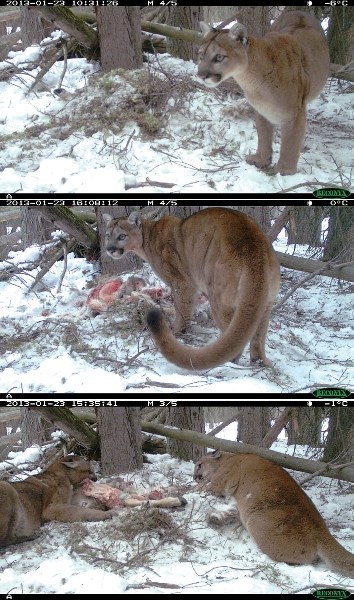Banff residents have some interesting neighbours just outside their back doors – four elusive cougars were recently caught on camera feasting on a dead deer on Sulphur Mountain.
A motion-activated camera captured images of a female cougar and her kitten feasting on a dead mule deer on Jan. 23 before being chased off the kill by two larger wild cats, perhaps siblings or maybe a breeding pair.
Cougars are very efficient killers and strike fear in many people, but these images from a remote battery-operated camera offer a rare and privileged view of the wild cats going about their everyday lives.
“It shows cougars doing what cougars are naturally meant to be doing,” said Steve Michel, a Parks Canada human-wildlife conflict specialist for Banff National Park.
“It’s pretty impressive footage showing there were four cougars in that one location in just a 48-hour period. The two adults stayed on the kill and cleaned it up.”
Snow tracking this winter has revealed there are three or four adult female cougars, accompanied by offspring of various ages and litter sizes. All told, there are about three young kittens and three sub-adults.
In addition, there are two or three more adult cougars not accompanied by offspring, two of which were travelling together to claim that recent kill above a residential neighbourhood on Sulphur Mountain.
The big cats have been using wildlife corridors, including on the slopes of Sulphur Mountain, along the Banff Springs golf course, on Tunnel Mountain and on the north side of the Trans-Canada Highway in the Cascade Corridor.
Michel said there hasn’t been a spike in cougar activity around the townsite, but snow on the ground allows for cougars and other carnivores to be tracked in the wildlife corridors.
He said cougars feed mostly on mule deer, but they will take down other animals, and trackers recently found the remains of a red fox in one of the corridors killed by a cougar.
“December, January and February is a time of year that we have a better window into the lives of what these animals are doing because of the snow on the ground,” said Michel.
“There seems to be a lot of activity in those various corridors, from several different cougars, but it’s in predictable locations and we’re not seeing anything out of the ordinary or unusual.”
The cougar is North America’s largest wildcat, and in Alberta lives in the mountains and foothills, preferring remote, wooded and rocky areas. A large male can be as long as three metres.
In these parts, cougars typically stay with their mothers until they’re around 18 months of age, before striking out on their home. Males are much more territorial than females and will aggressively defend their territory.
Cougars are highly elusive and prefer to avoid contact with people, so attacks on humans are rare. Banff’s only cougar fatality was Frances Frost as she cross-country skied near Lake Minnewanka in 2001.
Michel said Parks Canada reminds residents and visitors that cougars are active on the landscape 12 months of the year and are travelling the outskirts of town.
He said people are urged to make noise, travel in groups, keep children close, leave iPods and headphones at home and have dogs on leash at all times.
“The reality is wild spaces can start 100 metres from your back door in Banff and that’s very different to people who live in downtown Calgary, where it’s a different environment to here,” said Michel.
“We want people to take appropriate precautions, keep safe and make sure they don’t have a negative encounter with wildlife. Negative encounters can happen if people don’t take appropriate safety precautions.”
The chance of seeing a cougar in the wilderness is very remote, and Michel said people would probably be surprised if they knew just how close to a cougar they could potentially be.
“People can spend their whole life in Banff and probably never see a cougar, but that doesn’t mean they have not been within 50 metres of one. A cougar would be aware of your presence even if you’re not aware of it,” he said.
“That’s a testament to just how few encounters actually happen. You can be in close proximity to carnivores on a regular basis, although completely unaware of it.”
Parks Canada asks that all carnivore sightings, including cougars, be reported to the Parks Canada dispatch at 403-762-1470.




